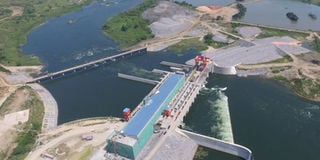Will Isimba dam reduce power tariffs?

Different shades. Isimba hydropower dam in Kayunga District. The project steering committee has raised a red flag over the Shs203b Isimba compensation bill. FILE PHOTO
What you need to know:
- Therefore, the government should address such challenges, increase consumption of electricity since low demand increases the tariffs among the few paying customers, and provide the much needed reliable and affordable electricity to spur growth and achieve universal access and sustainable energy for Ugandans.
Today, President Museveni with a host of other government officials and contractors, are expected to officially commission the much awaited Isimba hydro power dam in Kayunga District. This project that was first launched in 2013, will bring on additional 183MW of hydro electricity to the national grid .
This, therefore, marks an important milestone in the power and energy sector in the country. This will further increase the country’s installed generation total capacity from 984MW that was generated in 2018 to 1167MW today.
Government officials have been assuring Ugandans that when Isimba dam construction is completed, it will add to the existing 45 major and mini-hydro power stations currently in Uganda and reduce the high electricity tariffs .Applying simple economics, we also know that when power supply increases, its price should reduce. So, with increased energy investments and increased power to supply both domestic and industrial demands, this should lower the cost of power in the short and medium-term.
Basing on the available estimates, when the first four turbines are switched on, Isimba dam will have the lowest power charges among the power stations in the country. It is projected that one unit of power is estimated to be sold to UEGCL at 4.16 US cents in the first 15 years and the be priced at 1.01 US cents after the elapse of 15 years, making it the cheapest power in the country.
This will offer a big relief to all Ugandans who are looking for affordable power tariffs for business and industrialisation. However, Uganda is known for good policy formulation, but poor in implementing polices.
When Bujagali dam was completed in 2007, Ugandans were promised lower power tariffs, but the tariffs skyrocketed instead. The Shs2.7 trillion borrowed for this project should, therefore, translate into lower power tariffs to reduce the cost of doing business. This is a big problem many industries face, according to World Bank.
However, if reduced tariffs are not realised, then this project will be among the many projects that have not benefitted citizens. We have also seen capacity problems where dams are constructed, but they operate below their installed capacity due to problems such as drought, low water levels, and other climatic change effects, among others.
Therefore, the government should address such challenges, increase consumption of electricity since low demand increases the tariffs among the few paying customers, and provide the much needed reliable and affordable electricity to spur growth and achieve universal access and sustainable energy for Ugandans.
Dan Denis Agaba,
[email protected]




